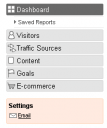If you don’t know who is visiting your site,
-
how they got there and what they are up to you might as well close up shop.
That is why so many of us spend so much time with web log analysis.
There are essentially two types of traffic analysers:
- Log based
- Javascript based
Log based analysers, such as webalizer, sawmill and awstats work on the logs that your web server has collected. You can garner a lot of information from web logs (and other types of logs too), but you won’t be able to get certain types of information easily.
With the Javascript based analysers you don’t even need to worry about your web logs, as the system reports to a remote server / service. While Javascript cannot detect every single aspect of the device browsing your site it can give you a lot more information about the browser being used, such as screen resolution etc.,
I’ve been using Awstats for a long time. It’s handy and fairly intuitive.
I’ve also been using Urchin since before its acquisition by Google and its subsequent transformation into Google Analytics.
I loved Urchin, but had a lot of reservations about the system once Google made it a free for all (the entire system fell over).
Over time they seemed to have got their act together, but the user interface was always a mess.
Trying to find out relatively simple things like “referrers” involved a lot of clicking about and changing user types. It was anything but intuitive.
Yes it is free, but as I’ve said more than once I don’t mind paying for things that make my life easier and had been paying for Urchin before the Google move.
In any case Google have just unveiled a new version of the interface and it is a significant improvement.
For the first time you can get to the information you want quickly and easily:

Compared to the old version:

Of course, as I am a cynic, I’ll probably discover that they’ve removed some key features, but for the moment I am impressed.
There are some nice little touches like the option to compare traffic for different periods.
So I can now see easily how much traffic I get on a site for a period this year compared to last year. The one issue with that part of the interface is that they’ve set it to use American date format. Hopefully that will be rectified, as it’s quite confusing.

You can also export to PDF now. The option to export to Word and CSV seems to have been removed or hidden on the main screen, though you can opt for those formats on the email report option.
I’m still exploring, but I like what I’ve seen so far. It’s a lot more intuitive, so you don’t spend as much time clicking around randomly in the hope of stumbling on the report you’re looking for.
Other reviews:
Peter Knight
IQ Content







Hi Michele
I’m looking forward to see what Microsoft are up to with Deepmetrix. BETA invites are being issued this summer and the features are almost identical and include…
* Click and visitor tracking
* Marketing campaign reporting
* Conversion tracking
* Demographic and geographic segmentation
* Paid and natural search analysis
It’s called project Gatineau
Michele,
Another very useful post, thanks. For a long time my own little blog has been generating a few hits every day, but since I registered my own domain name (francismahon.com… shameless plug), the traffic has taken a jump. I had been using statcounter.com, nice little system, keeps the last 100 page views. Now that I’ve set-up an Analytics account, I’m impressed by the volume and quality of the information it gives me – it’s not that I NEED to know what the traffic is like, or even that I’m looking at monetizing my site – it’s just interesting to see hits coming in from all over the world…
Fran
Fran
you have to be careful! Log watching can be addictive 🙂
Michele
I am still stuck with the old interface.
Paul
That’s odd. I thought they’d upgraded everyone at this stage!
M
I think I will email google support to see why I have not been upgraded.